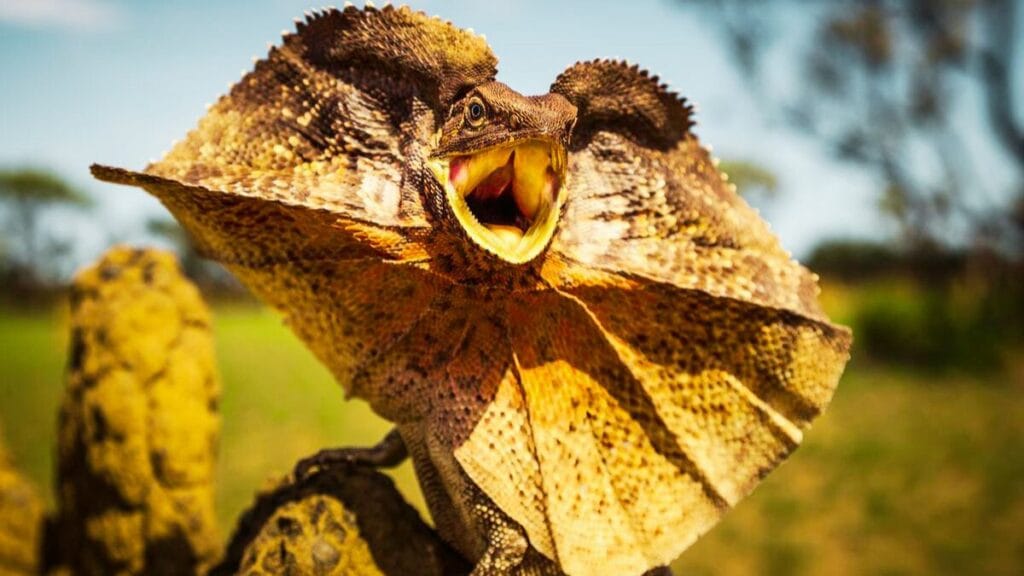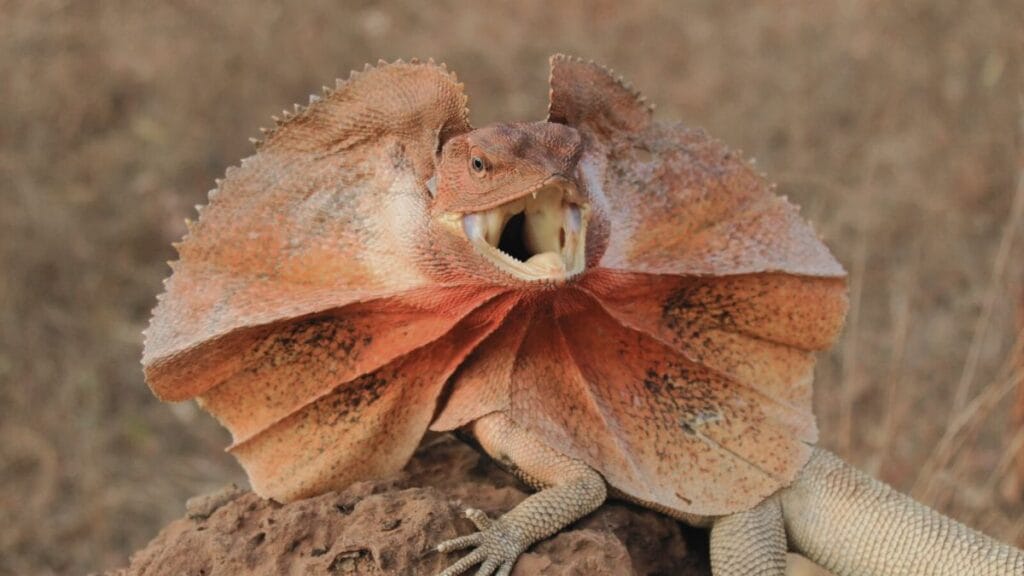Frilled lizards, also known as frilled agama, the frillneck lizard, the frill-necked lizard, and the frilled dragon, are native to northern Australia and southern New Guinea and are known for the large frill around their necks.

Frilledneck lizards are viral reptiles on social media for their beauty and unconventional style. The species received special attention when a frilled lizard climbed on the back of a traveller while he was roaming in a forest in Australia.
Why In the News?
A video went viral on Instagram a while ago when a user, Enzo Semaskovish, had a close encounter with a frilled-neck lizard while exploring Australian forests.
Enzo captured the video and shared it on his social media handle with the caption, “When a lizard mistakes you for a tree”.
A few days later, a similar video surfaced on the internet with 20 million views. when a frilled lizard was seen in an empty road and a person approached it.
Immediately, the lizard inflates its neck and opens its mouth and follows the person wherever he goes. Finally, the lizard climbs onto the person’s back and starts showing its dangerous form.
7 Fun Facts About Frilledneck Lizards:
Frilled lizards are native to Oceania:
Frilled lizards are primarily native to Australia and New Guinea. However, you may find them in New Zealand and other islands.
These lizards prefer to inhabit the woodlands, moist tropical and warm-temperate forests, and shrubby understories.
Males are larger than females:
Frilled dragons can grow up to 90 cm or 35 in from head to tail-tip and weigh around 600 g (1.3 lb). While resting, their frills fold down on their shoulders, and while displaying, the frill is around 9.5-14 inches (24-34 cm) wide.
Sexual dimorphism is present in these lizards, as males grow larger and more robust than females. Their bodies are grey, brown, orangish-brown, or black, whereas their frills are red, orange, yellow, or white.

These lizards are arboreal:
Frilled lizards spend most of their time in the trees, and they are most active in wet seasons. They are often seen near or on the ground in rainy seasons, whereas they seek shade in the branches of the upper canopy.
Frilledneck lizards are omnivorous:
Despite being omnivorous, frilledneck lizards primarily consume carnivorous diets such as insects and other invertebrates, such as moth larvae, spiders, cockroaches, worms, etc. In the absence of a carnivorous diet, they also feed on seeds, flowers, and fruits.
Frilled lizards are not poisonous:
Frilled lizards may look scary, like tiny dinosaurs, but they are actually harmless. Whenever they are threatened, they expand their frills and try to scare the predators.
Frilledneck lizards are not poisonous to humans or any other animal, but they have shaped teeth. You may feel severe pain if they bite you with their sharp teeth.
These lizards were consumed by people:
Frilled dragons are one of the most iconic Australian animals, along with the Kangaroo and Koala. According to archaeological evidence, these lizards were eaten by indigenous tribes and local people.
Frilled lizards are not suitable pets:
Frilledneck lizards are wild animals and don’t prefer human companions. Whenever they notice humans, they run after the person and suddenly climb on their back and enlarge their frills.
However, frilled lizards are bred in captivity recently, but as a pet, they can create lots of trouble for you. They are very difficult to train and very disease-prone. The life expectancies are not known for frilled lizards, but in captivity, they can live 10-15 years.
They also need specific environments and conditions to survive, which is very difficult for a first-time or inexperienced owner to recreate.
Hence, it is advised not to keep frilled-neck lizards as pets and to let them live happily in the wild. If you find any injured lizards, take them to the nearby rehabilitation centre and ensure their safety.
Also Read: 9 Lesser-Known Facts About Zebra-Tailed Lizards Might Shock You
Also Read: 6 Fun Facts About The Dire Wolves May Surprise You
Also Read: Savannah Monitor Lizards: 7 Facts You Must Know Before Keeping Them As Pets